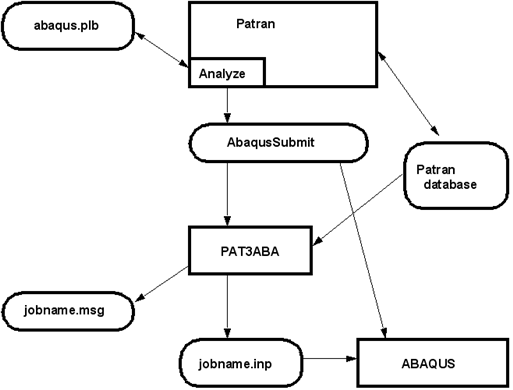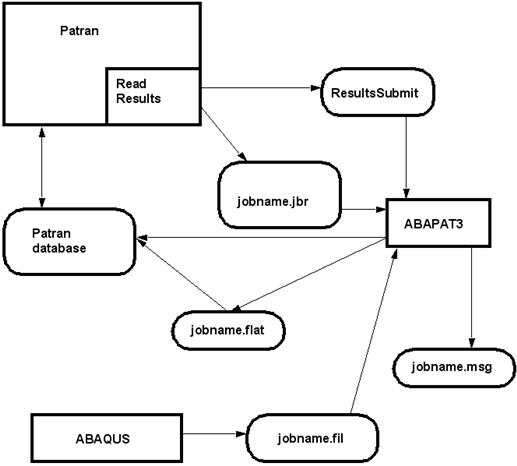XXXXXXXXXXXXXXXXXXXXXXXXXXXXXXXXXXXXXXXXXXXXXXXXXXXXXXXXXXXXXXXXXXXXXXXXXXXXXXXXXXXXXXXXXXXXXXXXXXXXXXXXXXXXXXXXXXXXXXXXXXXXXXXXXXXXXXXXXXXXXXXXXXXXXXXX''"> Patran ABAQUS Integration with Patran
Two diagrams are shown below to indicate how these files and programs fit into the Patran environment. In some cases, site customization of some of these files is indicated. Please see the Patran Installation and Operations Guide for more information on this topic.
Figure 1‑1 shows the process of running an analysis. The
abaqus.plb library defines the various Translation Parameter, Solution Type, Solution Parameter, and Output Request forms called by the Analysis form. When the Apply button is selected on the Analyze form, a
.jba file is created, and the script
AbaqusSubmit is started. This script
may need to be modified for your site installation. The script, in turn, starts the PAT3ABA forward translation. Patran operation is suspended at this time. PAT3ABA reads data from the database and creates the ABAQUS input deck. A message file is also created to record any translation messages. If PAT3ABA finishes successfully, and you have requested it, the script will then start ABAQUS.
Figure 1‑1 Forward Translation
Figure 1‑2 shows the process of reading information from an analysis results file. When the Apply button is selected on the Read Results form,
a .jbr file is created, depending on whether model or results data is to be read. The
ResultsSubmit script is also started. This script may need to be modified for your site installation. The script, in turn, starts the ABAPAT3 results translation. The Patran database is closed while this translation occurs. A message file is created to record any translation messages. ABAPAT3 reads the data from the ABAQUS results file. If ABAPAT3 can find the desired database, the results will be loaded directly into it. If, however, it cannot find the database (for example, if you are running on several incompatible platforms), ABAPAT3 will write all the data into a flat file. This flat file can be taken to wherever the database is and read in using the read file selections.
Figure 1‑2 Results Translation


